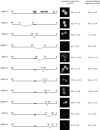Multiple cis-acting sequences mediate upregulation of the MDR1 efflux pump in a fluconazole-resistant clinical Candida albicans isolate
- PMID: 16801405
- PMCID: PMC1489804
- DOI: 10.1128/AAC.00196-06
Multiple cis-acting sequences mediate upregulation of the MDR1 efflux pump in a fluconazole-resistant clinical Candida albicans isolate
Abstract
Overexpression of the MDR1 gene, which encodes a multidrug efflux pump of the major facilitator superfamily, is a frequent cause of resistance to the antimycotic agent fluconazole and other metabolic inhibitors in clinical Candida albicans strains. Constitutive MDR1 overexpression in such strains is caused by mutations in as yet unknown trans-regulatory factors. In order to identify the cis-acting sequences in the MDR1 regulatory region that mediate constitutive MDR1 upregulation, we performed a promoter deletion analysis in the genetic background of an MDR1-overexpressing clinical C. albicans isolate. We found that several different regions in the MDR1 promoter can mediate MDR1 overexpression in this isolate. In contrast, deletion of one of these regions abolished benomyl-induced MDR1 expression in a C. albicans laboratory strain. These results suggest that multiple transcription factors control expression of the MDR1 efflux pump in C. albicans and that the mutation(s) that causes constitutive MDR1 overexpression and drug resistance in clinical C. albicans isolates affects the activities of several of these transcription factors.
Figures




Similar articles
-
Overexpression of the MDR1 gene is sufficient to confer increased resistance to toxic compounds in Candida albicans.Antimicrob Agents Chemother. 2006 Apr;50(4):1365-71. doi: 10.1128/AAC.50.4.1365-1371.2006. Antimicrob Agents Chemother. 2006. PMID: 16569853 Free PMC article.
-
MDR1-mediated drug resistance in Candida dubliniensis.Antimicrob Agents Chemother. 2001 Dec;45(12):3416-21. doi: 10.1128/AAC.45.12.3416-3421.2001. Antimicrob Agents Chemother. 2001. PMID: 11709317 Free PMC article.
-
Gain-of-function mutations in the transcription factor MRR1 are responsible for overexpression of the MDR1 efflux pump in fluconazole-resistant Candida dubliniensis strains.Antimicrob Agents Chemother. 2008 Dec;52(12):4274-80. doi: 10.1128/AAC.00740-08. Epub 2008 Sep 22. Antimicrob Agents Chemother. 2008. PMID: 18809934 Free PMC article.
-
Regulation of multidrug resistance in pathogenic fungi.Fungal Genet Biol. 2010 Feb;47(2):94-106. doi: 10.1016/j.fgb.2009.08.002. Epub 2009 Aug 7. Fungal Genet Biol. 2010. PMID: 19665571 Review.
-
The genetic basis of fluconazole resistance development in Candida albicans.Biochim Biophys Acta. 2002 Jul 18;1587(2-3):240-8. doi: 10.1016/s0925-4439(02)00087-x. Biochim Biophys Acta. 2002. PMID: 12084466 Review.
Cited by
-
Differential requirement of the transcription factor Mcm1 for activation of the Candida albicans multidrug efflux pump MDR1 by its regulators Mrr1 and Cap1.Antimicrob Agents Chemother. 2011 May;55(5):2061-6. doi: 10.1128/AAC.01467-10. Epub 2011 Feb 22. Antimicrob Agents Chemother. 2011. PMID: 21343453 Free PMC article.
-
Transcriptional activation and increased mRNA stability contribute to overexpression of CDR1 in azole-resistant Candida albicans.Antimicrob Agents Chemother. 2008 Apr;52(4):1481-92. doi: 10.1128/AAC.01106-07. Epub 2008 Feb 11. Antimicrob Agents Chemother. 2008. PMID: 18268086 Free PMC article.
-
Inducible and constitutive activation of two polymorphic promoter alleles of the Candida albicans multidrug efflux pump MDR1.Antimicrob Agents Chemother. 2012 Aug;56(8):4490-4. doi: 10.1128/AAC.00264-12. Epub 2012 May 21. Antimicrob Agents Chemother. 2012. PMID: 22615278 Free PMC article.
-
Transcriptional Response of Candida auris to the Mrr1 Inducers Methylglyoxal and Benomyl.mSphere. 2022 Jun 29;7(3):e0012422. doi: 10.1128/msphere.00124-22. Epub 2022 Apr 27. mSphere. 2022. PMID: 35473297 Free PMC article.
-
Multidrug resistance in fungi.Eukaryot Cell. 2007 Nov;6(11):1933-42. doi: 10.1128/EC.00254-07. Epub 2007 Sep 14. Eukaryot Cell. 2007. PMID: 17873085 Free PMC article. Review. No abstract available.
References
-
- Alarco, A. M., I. Balan, D. Talibi, N. Mainville, and M. Raymond. 1997. AP1-mediated multidrug resistance in Saccharomyces cerevisiae requires FLR1 encoding a transporter of the major facilitator superfamily. J. Biol. Chem. 272:19304-19313. - PubMed
-
- Coste, A. T., V. Turner, F. Ischer, J. Morschhäuser, A. Forche, A. Selmecki, J. Berman, J. Bille, and D. Sanglard. 2006. A mutation in Tac1p, a transcription factor regulating CDR1 and CDR2, is coupled with loss of heterozygosity at chromosome 5 to mediate antifungal resistance in Candida albicans. Genetics 172:2139-2156. - PMC - PubMed
-
- de Micheli, M., J. Bille, C. Schueller, and D. Sanglard. 2002. A common drug-responsive element mediates the upregulation of the Candida albicans ABC transporters CDR1 and CDR2, two genes involved in antifungal drug resistance. Mol. Microbiol. 43:1197-1214. - PubMed
Publication types
MeSH terms
Substances
LinkOut - more resources
Full Text Sources
Other Literature Sources

